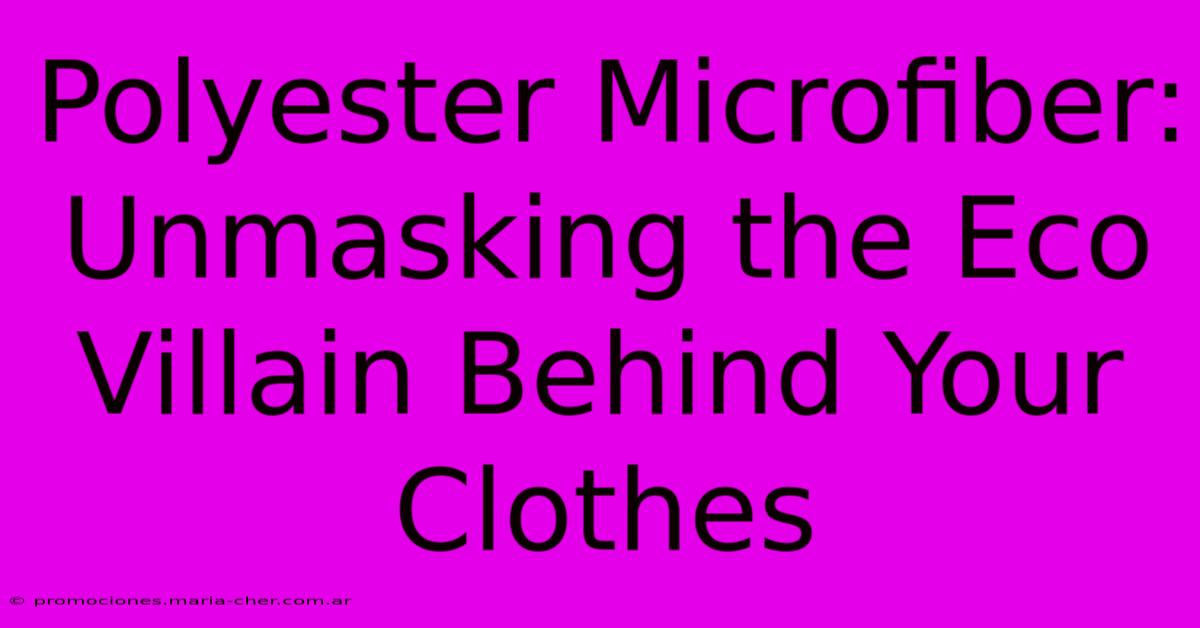Polyester Microfiber: Unmasking The Eco Villain Behind Your Clothes

Table of Contents
Polyester Microfiber: Unmasking the Eco Villain Behind Your Clothes
Polyester microfiber. The name might sound innocuous, even desirable – soft, durable, wrinkle-resistant. But behind the marketing sheen lies a troubling environmental reality. This ubiquitous fabric, found in everything from athletic wear to cleaning cloths, is increasingly recognized as a significant contributor to plastic pollution and a major threat to our ecosystems. This article delves into the dark side of polyester microfiber, exploring its environmental impact and examining potential solutions.
The Problem with Polyester Microfiber
Polyester, a synthetic fiber derived from petroleum, is inherently unsustainable. Its production is energy-intensive and contributes significantly to greenhouse gas emissions. But the environmental damage doesn't stop there. The real eco-villain emerges in the form of microplastics.
Microplastic Pollution: A Growing Crisis
During washing, polyester garments shed tiny fibers – these are microplastics. These minuscule particles are too small to be effectively filtered by wastewater treatment plants, ending up in our oceans, rivers, and ultimately, the food chain.
- Oceanic Impact: Microplastics accumulate in marine environments, ingested by marine life. This leads to bioaccumulation of toxins, impacting the entire food web, including humans.
- Soil Contamination: Microplastics also contaminate soil, potentially affecting plant growth and soil health. The long-term effects of microplastic soil contamination are still largely unknown, but the potential for harm is significant.
- Airborne Microplastics: Studies show that microplastics are not only present in water but also in the air we breathe, highlighting the widespread nature of this pollution.
The Lifecycle of an Eco-Unfriendly Fabric
Understanding the full environmental impact of polyester microfiber requires examining its entire lifecycle:
1. Production: A Carbon Footprint
The production of polyester is heavily reliant on fossil fuels, resulting in substantial carbon emissions. The manufacturing process itself is energy-intensive and generates significant pollution.
2. Consumption: Fast Fashion's Impact
The popularity of fast fashion has fueled the demand for cheap, readily available polyester clothing. This "throwaway culture" contributes to the massive amounts of textile waste ending up in landfills.
3. Disposal: A Persistent Problem
Polyester doesn't readily biodegrade, meaning it persists in the environment for centuries. Even when incinerated, it releases harmful pollutants into the atmosphere.
What Can We Do?
The pervasive nature of polyester microfiber pollution requires a multi-pronged approach:
1. Consumer Choices: Making Sustainable Swaps
- Choose natural fibers: Opt for clothing made from sustainable and biodegradable materials like organic cotton, hemp, linen, or Tencel.
- Buy less, choose quality: Invest in durable, well-made clothing instead of constantly buying cheap, fast fashion items.
- Wash clothes less frequently and at lower temperatures: This reduces the shedding of microplastics.
- Use a laundry filter: Washing machine filters can help capture some of the shed microplastics.
2. Industry Innovation: Developing Sustainable Solutions
- Research and development: Investing in research to develop biodegradable or recycled polyester alternatives is crucial.
- Sustainable manufacturing practices: Implementing more environmentally friendly manufacturing processes can help reduce the carbon footprint of polyester production.
- Improved waste management: Better waste management systems are needed to handle textile waste effectively.
3. Policy and Regulation: Government Intervention
Governments need to implement stricter regulations on microplastic pollution, including potentially phasing out certain types of polyester fabrics.
Conclusion: A Call for Change
Polyester microfiber presents a significant environmental challenge. Addressing this issue requires a collective effort from consumers, the fashion industry, and policymakers. By making conscious choices, demanding sustainable alternatives, and implementing effective policies, we can collectively work towards mitigating the harmful effects of polyester microfiber and protecting our planet. The future of fashion depends on it.

Thank you for visiting our website wich cover about Polyester Microfiber: Unmasking The Eco Villain Behind Your Clothes. We hope the information provided has been useful to you. Feel free to contact us if you have any questions or need further assistance. See you next time and dont miss to bookmark.
Featured Posts
-
Unleash The Power Of Persuasion 5 Laws To Captivate Your Audience
Feb 09, 2025
-
The Future Of Volleyball Player Name S Predictions For The Next Generation
Feb 09, 2025
-
Polyester Unmasked Is It Worth The Hype The Ultimate Guide To Fiber Choices
Feb 09, 2025
-
Omelette Vs Omelet Which One Do You Choose When You Re Craving Eggs
Feb 09, 2025
-
Share The Sacrament With Loved Ones Delightful Communion Cards For All
Feb 09, 2025
